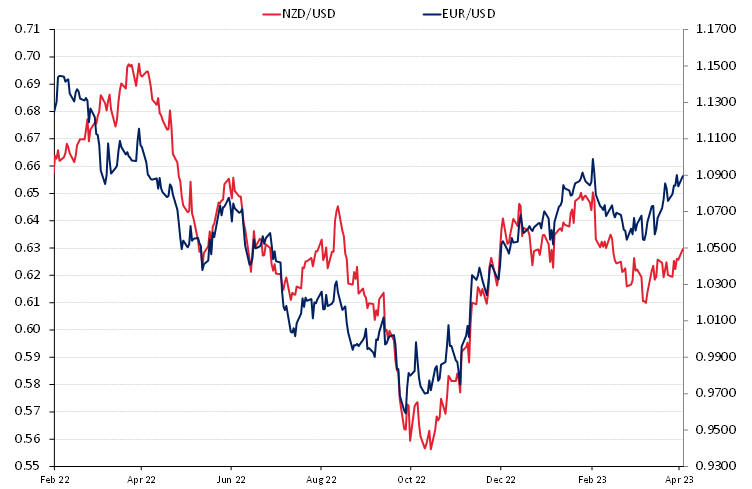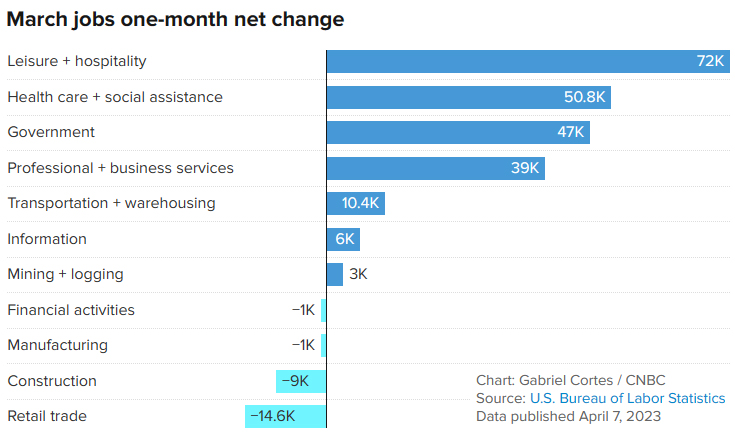
Summary of key points: -
- NZ and Australian central banks head off on different tangents
- Kiwi dollar fails to break-out of trading range, despite RBNZ surprise
- “Fed versus the markets” battle of wills continues
NZ and Australian central banks head off on different tangents
The current positions and projected outlooks for the New Zealand and Australian economies do not seem that different in terms of growth, inflation and commodity prices to warrant total polar opposite monetary policy stances. However, that is precisely what has been delivered to the financial/investment markets, businesses and households by the respective RBNZ and RBA with their recent interest rate decisions.
The RBNZ delivered a spectacular surprise (which Governor Adrian Orr is renowned for) to all and sundry last week with a 0.50% increase in the OCR to 5.25%. It appeared to be a panic decision based on the interest rate markets getting far too ahead of themselves (in the RBNZ’s eyes) in pricing future interest rate cuts too early. If the persistently high NZ inflation rate was coming from excessive consumer demand, one could understand the RBNZ going hard with a blunt tool to drive inflation down (interest rates). Sadly, that will cause pain and suffering as they drive the economy into recession. It is the harsh price that Kiwi businesses and households are now being forced to pay with an even tighter monetary policy at this time. Instead, the ongoing inflation is continuing to come from the supply side of the economy, as we witness every day with higher food prices caused by extreme labour shortages. Unfortunately, the RBNZ have had to go harder due to the previous excessive monetary/fiscal stimulus and miss-guided immigration policies.
In stark contrast across the Tasman, the RBA are pausing their interest rate increases at much lower levels than both New Zealand and the US. The RBA have the view that they have increased their interest rates enough to slow demand in the economy and that inflation will now come down. It looks like another classic monetary policy blunder by the RBA, similar to their crazy stance in early 2022 that they would not be increasing their interest rates until 2024. They were forced into increasing their interest rates in mid-2022. The financial markets will need to wait until Wednesday 26 April for the Australian March quarter’s inflation numbers before there is any gauge on whether the RBA have called this correctly. Or alternatively, whether they will be forced into another embarrassing U-turn of raising interest rates as the inflation rate is not reducing as they expected. The lagged impact of two and three year wage agreements being settled at higher levels in Australia and the impact that will have on future inflation seems to be currently dismissed by the RBA. Consensus forecasts for Australian CPI inflation for the March quarter are for a 1.20% increase which will pull the annual inflation rate down from 7.80% to 6.80%. An outcome above forecast will be very positive for the Aussie dollar as it would mean another RBA back-down on their current “pause” position with interest rate increases.
Over recent years we have seen the RBNZ and RBA marginally diverge on their monetary policy stances, however more in respect to timing differences than a fundamental opposite view. It could well be that both central banks have got this horribly wrong, the RBNZ have increased too much, and the RBA have not done enough. The implications for the respective exchange rates is that the NZD/AUD cross-rate can still go higher to well above 0.9400 in the short-term. However, in about two months’ time when the RBA see the error of their ways, the AUD will outperform the NZD against the USD and the NZD/AUD cross-rate will be bumped back sharply downwards to the 0.9100 area.
Kiwi dollar fails to break-out of trading range, despite RBNZ surprise
The widely held expectation from the FX markets would be that the NZD/USD exchange rate would be propelled higher on its own account on a massively positive catalyst such as the RBNZ unexpectedly hiking the official interest rate by 0.50%, when 0.25% was the prior market pricing. Our column has previously encouraged the RBNZ to do something to push the exchange rate higher as a less damaging method to bring the inflation rate down (exporters already being well hedged against any NZD appreciation). However, on this occasion the Kiwi dollar only briefly spiked up to 0.6350 on April 5 when the RBNZ shocked the markets with their decision. The 0.6300 level has been a barrier on the topside for the Kiwi dollar over the last two months and it has again failed to sustain itself above that point, returning to 0.6250 within 24 hours on 7 April.
The reasons as to why the NZ dollar has not (as yet) attracted offshore buying interest in response to the higher NZ interest rates are arguably twofold: -
- Dairy prices lower again – dairy commodity prices were again sharply lower at the GDT auction on 4th April. The overall GDP price index was down 4.70% to US$3,227/MT and Whole Milk Powder prices decreased 5.20% to US$3,053/MT. The expected increase in Chinese demand has not materialised due to their locally produced milk supply increasing.
- Worries that the potentially excessive tightening of monetary policy will lead to a more severe recession for the NZ economy, negative for the NZ dollar on a relative economic performance measure.
We do not see the above two factors holding the Kiwi dollar back for two long. The sentiment and direction of the US dollar itself remains firmly negative as the Fed nears the end of its monetary tightening cycle. The chart below confirms once again just how much the Kiwi dollar has under-performed the Euro against the USD since February. History tells us that the NZD/USD exchange rate out-performing and under-performing the EUR/USD rate never lasts for too long, therefore a NZD catch-up to 0.6500 (aligning with the $1.0900 EUR/USD rate) has to be increasing in probability.

“Fed versus the markets” battle of wills continues
Up until the US jobs figures for the month of March last Friday, the US interest rate markets were continuing to push yields lower in anticipation of the Fed nearing the end of its monetary tightening cycle. US 10-year Treasury Bond yields traded to a new low of 3.26% on 7 April from 4.05% in early March. The 2-year yield plunged to 3.70% from a high of 4.94% in early March. The USD was weaker on global FX markets as a result. Both interest rates have backed-up a touch to 3.41% and 3.99% respectively following the 233,000 increase in March jobs (in line with expectations). Going forward, our view is that the Fed will become less concerned with the strength of the labour market as a threat to inflation as the associated wage increases continue to moderate. Consistent with previous months employment data in the US, the March numbers confirmed that the all the new jobs were in the lower paid hospitality/leisure sector and the healthcare and Government sectors (refer bar chart below). Manufacturing, construction and retail sectors all recorded a contraction in jobs. The net result of these labour market trends is that upwards wages pressures are moderating and therefore inflation pressures also reducing.

The equity, FX and bond markets will continue to price a soft landing for the US economy i.e. they expect the evolving economic data to convince the Fed to pause and pivot on interest rate hikes over the next 12 months. At this point that Fed do not want to see the markets pricing interest rate cuts this year, however the markets will not change their pricing if the data continues on the weaker side. As expected, bank credit conditions have tightened considerably in the US, leading to weaker data ahead. US March inflation data this Thursday morning 13 April is likely to result in a lower core inflation increase than the +0.40% prior forecasts suggest. Further USD selling will follow.
We have previously noted that the banking problems in the US would lead to safe-haven capital flows away from the US and into banks and equity markets in China/Asia (a positive for the NZD and AUD). Emerging markets shares attracted strong inflows in March. Data from TD Securities confirms US$10 billion departed US equities in March and US$5 billion was invested in Emerging Market equities and US$5 billion invested into China. Expect these trends in capital flows to also continue.
Daily exchange rates
Select chart tabs
*Roger J Kerr is Executive Chairman of Barrington Treasury Services NZ Limited. He has written commentaries on the NZ dollar since 1981.
12 Comments
Thank you Roger for writing about the different course of the RA and RBNZ and also about the Fed vs the market. I think these are two very important and interesting paths and expectations. I have been surprised no one wrote about these two subjects before.
Interesting times!
Both approaches are reasonable given the economic situation in their respective country. As long as inflation is decreasing around 1% per quarter they can both still get back to the target inflation rate by 2024. On the 20th of April we will have a CPI release for New Zealand and on the 26th that CPI data set will be released for Australia so we will get to see how they are tracking.
What might spook them a bit are signs of re-inflation in energy (ultimately in an industrialised economy the cost of energy is the cost of everything.)
Since Q3 2022 the kiwi had been trending UP
However last weeks ill-advised (wrong) interest rate decision has changed all that. The NZD/USD has fallen from 0.637 and now another 0.7 pct overnight to 0.621. Thats big. Roger says
- Worries that the potentially excessive tightening of monetary policy will lead to a more severe recession for the NZ economy, negative for the NZ dollar on a relative economic performance measure.
Orr (aka Eeyore) has got the rate hike wrong and the markets know it. The Gnats will sack him early next year and tell poor Adrian to "take a hike". It was a costly decision by Robertson to reappoint him
"Look mate, you have done a really bad job for the last 5 years, how about we reappoint you? How about we for your terrible performance we give you almost double the pay of the PM?"
Oh I forgot, he made sure the retail banks made absolute mega bucks, while screwing the poor/middle through inflation denial as a result of the biggest unsupported money printing splurge the country has ever seen. Then he gets to mark his own homework to say he is doing an amazing job. Now he over tightens because he doesn't understand the lag conditions in his previous decisions.
I mean, its crazy. The whole financial system is looking like a total back slapping bunch of out of touch self interested idiots out to enrich their mates in the banking industry, so they have a nice place to land after they exit their cushy job with a golden handshake. No wonder more and more young people see the idiocy and decide to not participate so go to crypto etc instead.




We welcome your comments below. If you are not already registered, please register to comment.
Remember we welcome robust, respectful and insightful debate. We don't welcome abusive or defamatory comments and will de-register those repeatedly making such comments. Our current comment policy is here.